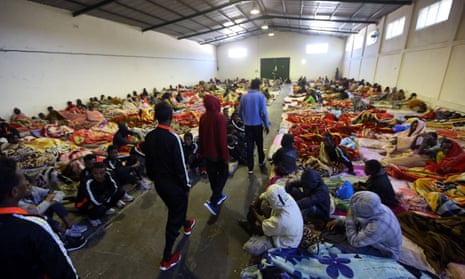Refugees and migrants trying to reach Europe from Africa are being subjected to horrific and routine sexual violence in Libyan detention centres, a survey has found.
People arriving at the centres are “often immediately raped by guards who conduct violent anal cavity searches, which serves the dual purpose of retrieving money, as well as humiliation and subjugation”, the report by the Women’s Refugee Commission says. Many of the victims have been forcibly returned to the country by the Libyan coastguard under policies endorsed by the European Union.
The level of psychological treatment for victims of sexual violence who reach Italy is woefully inadequate, the report adds.
Sarah Chynoweth, the lead researcher on the report, said: “Profoundly cruel and brutal sexual violence and torture are perpetrated in official detention centers and clandestine prisons, during random stops and checkpoints, and in the context of forced labor and enslavement. The fact that refugees and migrants crossing the Mediterranean are intercepted and forced back into this violence is untenable.”
The report, released at the Swedish mission in Geneva, is based on surveys and focus groups of people who have reached Italy. Much of the sexual violence it describes is too graphic to detail, but the authors make the broad point that “during the course of this research, almost all refugees, migrants, and key informants emphasised that sexual violence against male and female migrants along the entire central Mediterranean route was exceptionally high”.
A UN officer estimated that 90% of male refugees and migrants being hosted in the Italian reception system had experienced sexual violence during their journey. A local government official said that, among refugee and migrant boys, “although there are no real numbers, we know that a huge number of the minors have experienced sexual violence on the journey [to Italy]”.
The extent of sexual violence perpetrated against refugees appears in part to be contingent on their financial resources, their connections, and the year that they travelled – those traveling in recent years are seemingly more likely to have experienced sexual violence.
In many cases, sexual violence and torture are filmed on Skype and used to try to extract ransom money from the victims’ relatives, the report by the Swedish-funded, US-based commission says.
Refugees, migrants and informants told researchers that sexual violence was commonplace throughout the journey to Italy. “All along the journey they experienced sexual violence,” a health provider reported. “The whole journey is traumatic. Libya is just [the] icing on the cake.”
It had been thought that the dominance of young males in the Libyan refugee trail would reduce the risk of sexual violence. It is estimated 72% of sea arrivals in Italy were men and 18% were children, mainly unaccompanied boys.
In response to questions about sexual violence in Libya, refugees and migrants variously told the researchers that it “happened to everyone”, “is normal in Libya”, “happened to all people inside Libya” and “happened to many, many of my friends”.
Only two refugees among those surveyed explicitly reported that they had not been exposed to sexual violence, due to their ability to pay large sums in exchange for relatively safe passage.
A mental health provider in Italy working with refugees and migrants said that most of the men he spoke to had been raped in centres in Libya. A protection officer commented: “It is so widespread. Everyone knows when a man says”: ‘I’ve gone through Libya’ it is a euphemism for rape.”
Among the forms of sexual violence described to researchers was anal and oral rape, forced rape of others including corpses, castration and forced incest.
Much of the sexual violence described by research participants contained elements of profound psychological torture and cruelty.
Violence against detainees is frequently perpetrated in front of others or recorded on mobile phones, compounding the humiliation and reinforcing the experience of subjugation, the researchers found. “Perpetrators send (or threaten to send) the video footage to detainees’ family members for extortion purposes,” the report says.
A commonly reported torture technique involved forcing men to stand in a circle to watch the rape and sometimes murder of women; men who moved or spoke out were beaten or killed.
Health and mental health providers who had treated male survivors frequently reported electroshock burns to the genitals. Other genital violence included beating, burning, tying and “pulling of the penis and scrotum”.
In February 2017, Italy made a deal, backed by the EU, to spend tens of millions of euros funding the Libyan coastguard, which intercepts boats heading for Italy and returns those onboard to Libya.
From January 2017 to September 2018, the Libyan coastguard intercepted and forcibly returned more than 29,000 people. Many ended up in detention centres or disappeared altogether.
